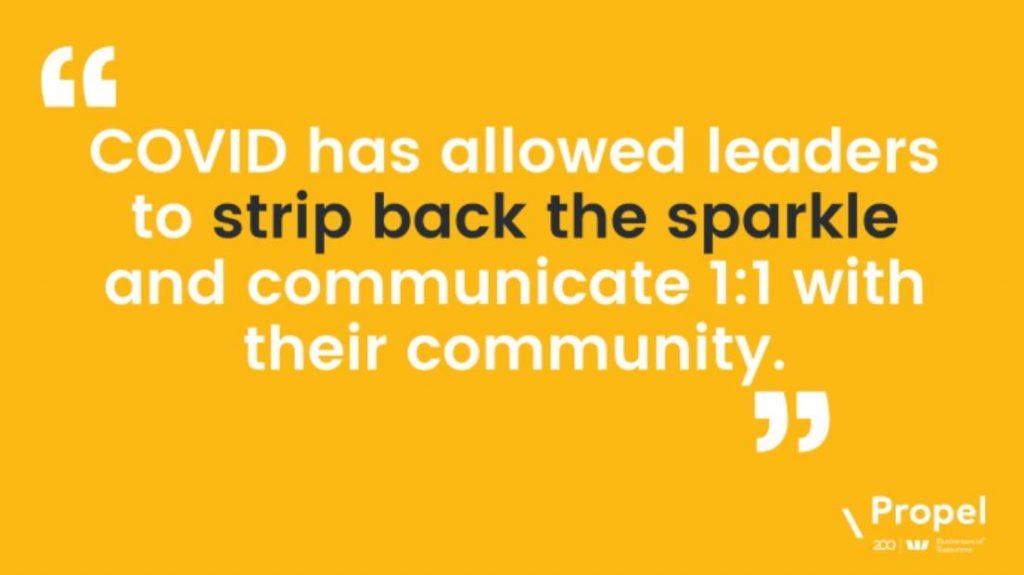What is coronavirus social media best practice and how should you be using social media during the COVID-19 pandemic? Propel’s ‘Coronavirus Social Media Best Practice’ series continues to help answer these important questions. We hope these tips from our own experience and experts in their field are sparking new conversations as we all adapt to this new normal. Thank you to all those who have been in touch to offer their two cents. If you have a key learning or best practice piece of advice from your experience managing social media throughout the COVID-19 crisis, we’d love to hear from you.
If you’ve missed tips 1 – 10 in our coronavirus social media best practice series, click here to catch up on part one and part two.
Check in on staff mental health.
This is a slightly different post for our coronavirus social media series, as I simply want to acknowledge the great work being done by the Canada School of Public Service | École de la fonction publique du Canada.
We’ve talked already about the importance of checking in on staff mental health at a time when many workforces are stretched and facing a deluge of anxious customer queries. Social media staff are very much at the front line and, sadly, often face more vicious criticism with consumers happy to vent via their keyboards.
So I was delighted to see an email go out from the Canadian Government highlighting resources, courses and content produced to help those struggling with current pressures. Even job aids for team managers. Thank you to the team for sharing this link to a whole range of great resources along with this video featuring tips for managers during this COVID-19 crisis. We appreciate your spirit of collaboration.
Bravo, guys.
I know organisations are doing this in other ways, too – some with resilience training specifically tailored for social media and service teams. Please thank and acknowledge those organisations you know are going the extra mile to support staff at this time – they thoroughly deserve the credit.
Stay on top of social media complaints during COVID-19.
I read a fascinating article from Harvard Business Review that looked at whether it’s possible to stop the spread of social media complaints during times like COVID-19.
The answer is yes. But what’s most important is ‘how’.
Research referenced in the article looked at almost half a million negative social media comments posted in the public Facebook communities of orgs in the S&P 500. The findings?
- Firstly, around 15,000 or 3% of all those posts went viral;
- You need to respond, and respond fast on social media;
- There are five common approaches: moving the conversation to a private channel (61%), apologising (53%), providing an explanation (8%), expressing empathy (6%), and offering compensation (3%);
- Of these, apologies and switching to private generally lowered virality, when done quickly;
- However, offering to compensate an unhappy customer can often ‘fan the flames’.
So the key question for anyone managing a team through a crisis – do you have what you need to respond fast?
Use inbound query data to guide resourcing levels, leverage tech and triage to gain scale and speed, and remember to keep listening to your online communities to stay one step ahead. These practical measures will be the difference between containment and crisis.
Harness digital technology to keep abreast of evolving customer behaviour.

I was speaking with Aoife O’Connell – founder of chatbot and AI Business Yarnly AI – recently about the positive changes she’s seen during COVID-19.
I loved her answer: “The honesty, vulnerability and accessibility to the people behind the brands has been the main example of change. People want human connection. COVID-19 has allowed leaders to strip back the sparkle and communicate 1:1 with their community.”
What an honest and insightful look at where we are right now. And such a clear summary of what organisations stand to gain through direct, authentic customer engagement on social media.
In just one example, Aoife mentioned how her clients have had great success using Facebook Messenger chatbots to meet customers where they are and help resolve challenges instantly. No high-production value, no scripted messages – just helping people in need.
How are you ‘stripping back the sparkle’, harnessing digital technology and connecting with customers whose behaviours have changed for good?
Take a data-led approach to paid social media campaigns.
This may well have been a regular discussion topic within your team and organisation since early March as COVID-19 really took hold. And with the recent US tragedy and resulting global backlash, it’s even more important to have a clear strategy and understanding of your community brand perceptions.
I’ve been working closely with Ian Laurie at iD Social Pty for several months now and, as a leader in this space, I really respect his data-led approach to paid. His view?
“Be brave, be sensitive and be agile. Adjustments to ‘business as usual’ need to be made and agility is key as things are changing daily.
“Messaging needs to be much more sensitive, and be wary of being seen to profiteer from any situation.”
And while he stresses the importance of ‘reading community sentiment’, he has two vital considerations for anyone being asked questions around paid strategy right now:
- Don’t hide. This is a time to build your brand, build your audiences and gain insight and data.
- Don’t make presumptions. Watch the data, watch your dashboards and be prepared to move quickly.
Is your team currently facing a social media crisis? Click here for more information on our Social Media Crisis Management services or contact our Managing Director, Roger Christie to talk through your specific challenge and how we can help.